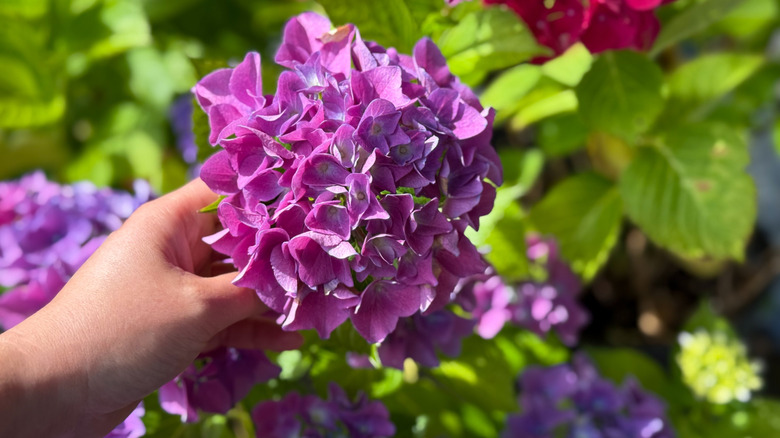The Very Best Shrubs To Plant With Hydrangeas As A Companion
Hydrangeas are a beautiful addition to any home garden, with countless varieties, colors, and sizes to choose from. They look great with just about anything, but when deciding what to plant next to your hydrangeas, it's important to choose a companion that complements these long-lived perennials both physically and aesthetically. Ideally, this partner will provide support for the hydrangea's heavy blooms without overpowering its grand appearance in the garden. That's where boxwoods come in.
Boxwood (Buxus spp.) is an evergreen shrub in the Buxaceae family that has been cultivated for thousands of years. A standard sight in privacy hedges, commercial borders, and landscaped gardens, boxwoods are known for their neat, low-maintenance habit. Their sturdy nature makes them a great natural fence alternative for your yard, and an even better match for your hydrangea's flexible branches. And with dozens of different species and hundreds of varieties available, it's easy to find the perfect match for your species of hydrangea.
Boxwoods and hydrangeas also thrive side by side because they have similar growing conditions. Boxwoods enjoy the same dappled shade and morning light that keep your hydrangeas happy, and both require moist but well-draining soil. These two popular plants are both stunners in their own right. But when combined, this tried-and-true pair brings a new level of elegance and practicality to your garden.
Hydrangea and boxwood: A tried-and-true combination
Boxwoods' strong stems and dense, trim-friendly foliage provide great physical support for sagging hydrangea branches weighed down by blooms or rain. Dwarf species, such as the popular littleleaf boxwood (Buxus microphylla), make superb natural barriers to hold up your heavy hydrangeas without blocking the view. Because their leaves remain through the winter, boxwood shrubs can also shield a hydrangea's delicate buds and new growth from late frosts. This can be crucial for species that bloom on new wood, such as panicle hydrangeas (Hydrangea paniculata) and smooth hydrangeas (Hydrangea arborescens).
When planted at the end of a garden bed, the taller American boxwood, also called common boxwood (Buxus sempervirens), may offer some protection from harsh winds. Growing up to 5 feet tall, American boxwoods are often used as a privacy hedge and can help prevent your hydrangea's bare stems from breaking in winter. This allows species that bloom on old wood, such as oakleaf hydrangeas (Hydrangea quercifolia) and bigleaf hydrangeas (Hydrangea macrophylla), to thrive as well.
However, if you're wondering why your bushes smell like cat pee, you may have planted a specific cultivar called English boxwood (Buxus sempervirens 'Suffruticosa'), which is known to give off an acrid, ammonia-like smell. Although most hydrangeas don't have a strong enough scent to fully mask this odor, some oakleaf varieties may offer a sweet escape for your nose while still reaping the benefits of this classic landscape combination.

